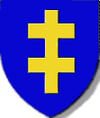Jagiellon dynasty

The Jagiellons were a royal dynasty that came from Lithuania and reigned in some Central European countries (present day Lithuania, Belarus, Poland, Ukraine, Latvia, Estonia, Kaliningrad, parts of Russia, Hungary, Czech Republic, Slovakia) between the 14th and 16th century.
Members of the dynasty were grand dukes of Lithuania 1377–1392 and 1440–1572, kings of Poland 1386–1572, kings of Hungary 1440–1444 and 1490–1526, and kings of Bohemia 1471–1526. The family was a branch of the Lithuanian Gediminaičių dynasty.
The name (other variations used in English include: Jagiellonians, Jagiellos, Jogailos, Jagiellas) comes from Jogaila (pol.: Jagiełło), the first Polish king of that dynasty.[1]
Jagiellon rulers[change | change source]
Jagiellons were hereditary rulers of Poland and Lithuania.
The Jagiellon rulers of Poland–Lithuania (with dates of ruling in brackets) were:
- Ladislaus (Jogaila) (in Lithuania 1377–1401; in Poland 1386–1434). (also known as Władysław II Jagiełło)
- Ladislaus III (1434–44)
- Casimir (1447–92)
- John Albert (1492–1501)
- Alexander (1501–05)
- Sigismund (1506–48)
- Sigismund Augustus (1548–72) (also known as Sigismund II)
Footnotes[change | change source]
- ↑ In Polish, the dynasty is known as Jagiellonowie (singular: Jagiellon, adjective, used of dynasty members, also patronimical form: Jagiellończyk); in Lithuanian it is called Jogailaičiai (sing.: Jogailaitis), in Belarusian Яґайлавічы (Jagajłavičy, sing.: Яґайлавіч, Jagajłavič), in Hungarian Jagellók (sing.: Jagelló), and in Czech Jagellonci (sing.: Jagellonec; adjective: Jagellonský), as well as Jagello or Jagellon (fem. Jagellonica) in Latin. In all variations of that name, the letter J should be pronounced as in "Hallelujah" (or as Y in "yes"), and G – as in "get".
Other websites[change | change source]
- Pages and Forums on Lithuanian history Archived 2020-09-22 at the Wayback Machine
- Jagiellonian Observatory
